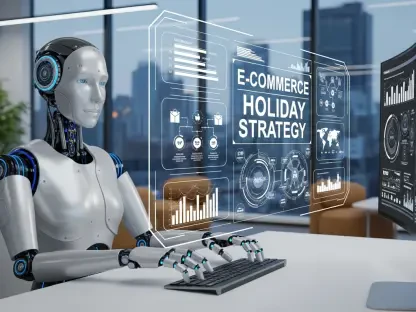In the world of digital transformation, Zainab Hussain stands out as an e-commerce strategist with a knack for customer engagement and operations management. Her career spans various retail landscapes, bringing a wealth of experience and insights into how to effectively harness market trends. Her understanding of blending technology with consumer needs is particularly relevant in today’s interconnected retail environment.
Can you share your initial thoughts and feelings upon being appointed as the Chief Marketing Officer at Webflow?
The opportunity to step into the role of Chief Marketing Officer at Webflow is incredibly exciting. It’s a pivotal time for the company as we delve deeper into AI and redefine what makes digital experiences unique and impactful. I feel energized by the chance to help guide Webflow on this journey and further develop its strong brand presence within the industry.
What attracted you to Webflow, and what do you find most exciting about joining the team at this moment?
Webflow’s reputation as a category-defining platform is certainly attractive. What excites me most is its commitment to pushing the boundaries of AI in digital marketing. The vision to enable teams and agencies to achieve extraordinary feats of creativity and innovation is something I’m eager to contribute to.
With your background at GitLab and Cloudflare, among other companies, how do you plan to leverage your previous experiences in your role at Webflow?
My time at GitLab and Cloudflare provided invaluable experience in scaling brands and executing strategies that appeal to both product-led and sales-led initiatives. At Webflow, I plan to utilize these skills to enhance our market positioning, build strong community relations, and drive our go-to-market execution with precision.
How did your experience at GitLab in leading platform positioning and launching new products prepare you for your role at Webflow?
Leading platform positioning and launching products like GitLab Duo AI gave me deep insights into crafting product narratives that resonate across various audiences. It taught me the importance of a cohesive story that aligns with the company’s vision, which is crucial as we introduce and develop AI systems at Webflow.
You have a strong background in brand storytelling and product marketing. How do you plan to apply these skills to the growth and innovation at Webflow?
Brand storytelling forms the backbone of effective marketing. At Webflow, I’ll focus on creating narratives that highlight our innovative spirit and how our tools empower users to harness the full potential of AI in their creative processes. By aligning our stories with actionable insights, we’ll drive significant engagement and growth.
Webflow is focused on deepening its AI product strategy. What is your vision for how AI will shape the future of Webflow’s offerings?
AI has the potential to revolutionize our platform by pushing the envelope of what users can achieve. My vision is to integrate AI in a way that amplifies creativity while ensuring performance and scalability remain at the forefront. We’re looking at AI not just as a tool, but as an enabler of transformative digital experiences.
Can you elaborate on how Webflow’s AI Site Builder aims to enhance the work of teams in terms of speed and precision?
The AI Site Builder is designed to streamline the site creation process, allowing teams to generate, organize, and deploy sites faster and more accurately. By eliminating bottlenecks in the workflow, AI provides a more dynamic and responsive platform, enabling users to focus on innovation rather than repetitive tasks.
Could you explain more about the role of Webflow Cloud and the Model Context Protocol in the company’s strategy?
Webflow Cloud and our Model Context Protocol play critical roles in blending web app capabilities with tailored testing environments. This integration allows developers to utilize our API more efficiently, optimizing build workflows. Together, they form a suite that addresses both infrastructure needs and creative aspirations.
You’ve worked with some of the biggest tech companies in the industry. Are there any particular insights or learnings from those experiences that you believe will be valuable at Webflow?
Innovation often thrives at the intersection of technology and customer needs. One key insight is to always remain adaptable and receptive to change, a philosophy I’ve carried from my previous roles. This mindset will be instrumental at Webflow as we navigate the nuances of AI and its role in our product ecosystem.
What do you think are the key challenges and opportunities in positioning Webflow as a leader in AI-powered digital experiences?
A major challenge is ensuring that our AI solutions are both intuitive and impactful, providing real value to users. The opportunity lies in differentiating our offerings and solidifying Webflow as a thought leader. By consistently delivering on our promise of creativity and scalability, we can secure our position at the forefront of AI-driven experiences.
How do you plan to navigate the dual focus on both creativity and scalability at Webflow?
Balancing creativity with scalability involves fostering an environment where innovation is encouraged, yet grounded in pragmatic strategies. At Webflow, I aim to implement systems that support creative workflows while also putting robust frameworks in place to ensure sustained growth and efficiency.
What role do you see for customer advocacy and community building in Webflow’s growth strategy?
Customer advocacy and community building are vital components of our strategy. They enhance credibility and foster a supportive ecosystem where users feel valued and empowered. By nurturing these relationships, we can create a feedback loop that fuels positive product developments and strengthens our community ties.
With AI reshaping how teams build on the web, what steps will you take to communicate Webflow’s unique value proposition to enterprise clients?
Clearly communicating our value proposition involves emphasizing the seamless integration of AI within our platform and the competitive edge it provides. By showcasing success stories and practical use cases, we can demonstrate how Webflow’s comprehensive suite empowers enterprise clients to achieve their goals.
As someone with experience in developing internet privacy standards, how do you plan to address privacy concerns in AI-driven digital platforms at Webflow?
Privacy is paramount, especially within AI-driven platforms. We will adhere to strict privacy standards and foster transparent practices concerning data handling. By establishing trust and ensuring compliance, we can safely advance our AI capabilities while respecting user privacy.
Finally, what are your long-term goals for Webflow’s marketing strategy, and how do you envision the brand evolving under your leadership?
My long-term goal is to position Webflow as the definitive platform for AI-powered digital experiences. As we evolve, we’ll strive to maintain a seamless blend of innovation and user-centric design, ensuring that Webflow remains synonymous with cutting-edge technology and creativity.









